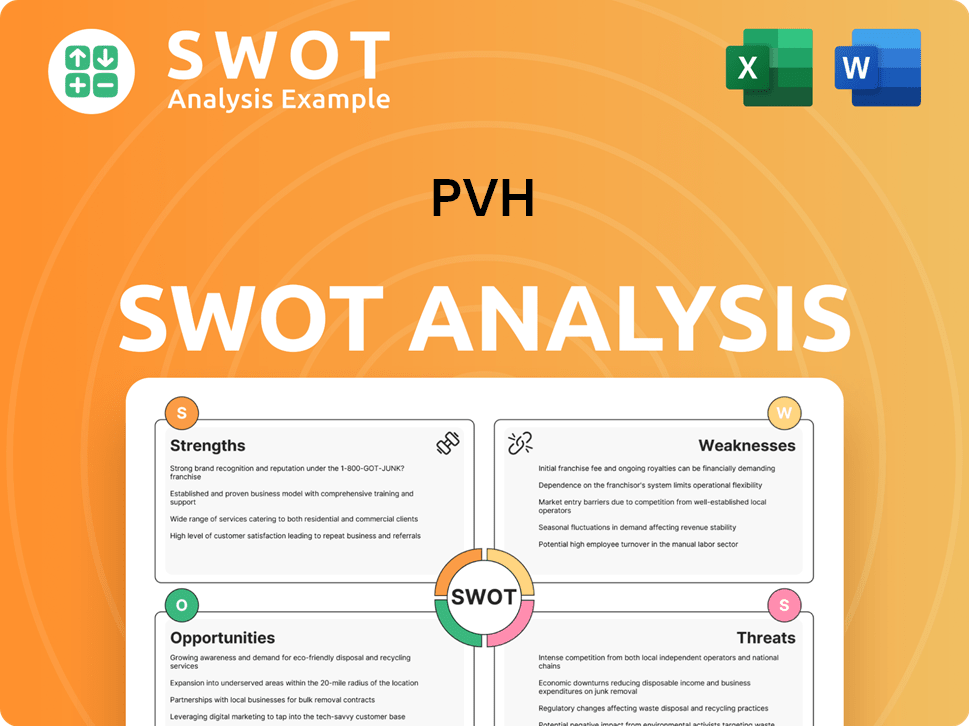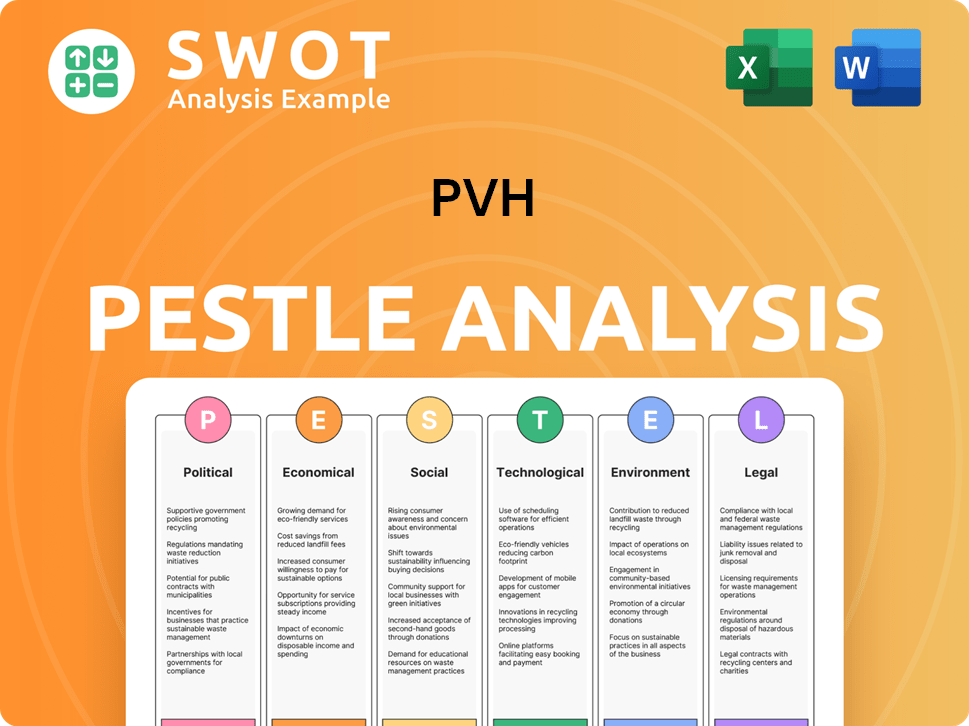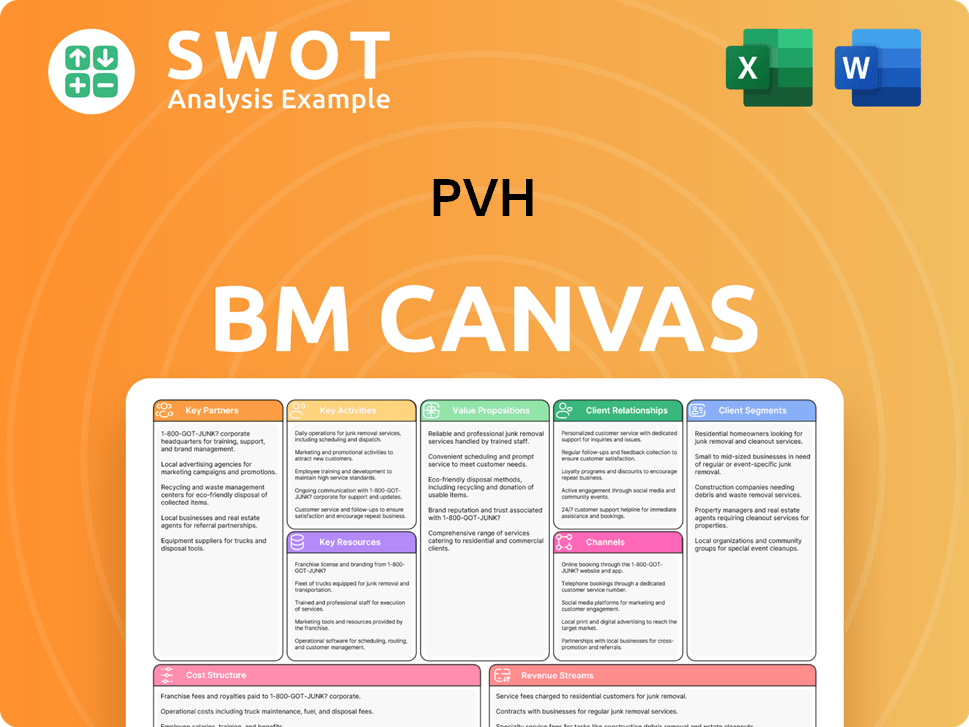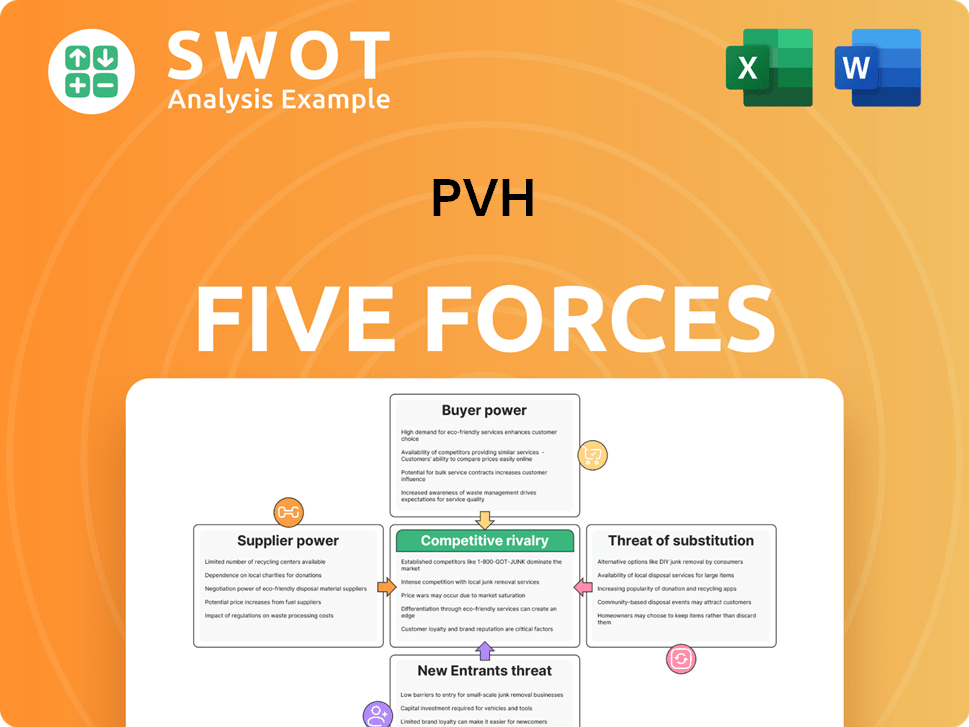PVH Bundle
Unveiling PVH's Customer: Who Buys Calvin Klein and Tommy Hilfiger?
In the ever-changing fashion landscape, understanding your customer is paramount. For a global leader like PVH Company, home to iconic brands, knowing the customer demographics and target market is the key to unlocking sustained success. This knowledge fuels strategic decisions, ensuring that product offerings and marketing efforts resonate with the right consumers. This analysis dives deep into PVH's customer profile, exploring the diverse segments that drive its global dominance.

From its origins in classic menswear, PVH has evolved into a global apparel powerhouse, necessitating a continuous re-evaluation of its customer base. This evolution, from a niche market to a broad, segmented consumer base, reflects the company's ability to adapt to shifts like the growing influence of Gen Z consumers. This exploration will uncover the demographic breakdown of PVH customers, including age range, gender distribution, income levels, and geographic locations, ultimately revealing how PVH strategically identifies and engages its target market through effective customer acquisition strategies and brand positioning.
Who Are PVH’s Main Customers?
Understanding the Customer demographics and target market of PVH Company is crucial for grasping its market position. PVH Company, a global apparel and accessories powerhouse, primarily caters to consumers (B2C) through a portfolio of iconic brands. Its success hinges on effectively reaching and resonating with diverse customer segments worldwide.
The company's market segmentation strategy focuses on distinct consumer profiles for each brand. This approach allows PVH brands to tailor their products, marketing, and overall brand experience to meet the specific needs and preferences of their respective target audiences. This targeted approach is a key factor in the company's sustained success.
The company's brand portfolio includes Calvin Klein and Tommy Hilfiger, each targeting different customer groups with unique characteristics. The company's strategic approach to customer demographics is a key element in its market success. This is supported by the company's financial performance; for example, in 2023, Calvin Klein's revenue was reported to be $3.8 billion, and Tommy Hilfiger's revenue reached $4.7 billion.
Calvin Klein's target market primarily consists of millennials and Gen Z individuals, typically aged between 18 and 35. This segment is drawn to the brand's contemporary, minimalist aesthetic, particularly in categories like underwear, denim, and fragrance. This group often resides in urban or suburban areas and values self-expression and cultural relevance.
Tommy Hilfiger's target market generally encompasses millennials and Gen X, roughly aged 25 to 45. This segment appreciates the brand's classic American cool and preppy-with-a-twist style. They often have a higher disposable income and seek quality, heritage, and versatile wardrobe options. Tommy Hilfiger's revenue reached $4.7 billion in 2023, making it the largest brand in PVH's portfolio.
PVH Company also serves customers through its Heritage Brands, though these represent a smaller portion of revenue and cater to more traditional consumer tastes. The company's customer base is global, with significant presences in North America, Europe, and Asia, reflecting its broad reach and diverse consumer base. The company's global strategy is a key driver of its financial performance.
Over time, PVH Company has adjusted its target segments. The increased focus on digital engagement and collaborations with influencers shows a strategic pivot to capture younger, digitally-native consumers. The company's emphasis on diversity and inclusion in its marketing campaigns also reflects an effort to broaden its appeal and resonate with a more diverse global customer base. These shifts are prompted by ongoing market research and the need to maintain relevance.
PVH Company's success is significantly tied to understanding and adapting to the evolving preferences of its target consumers. The company's approach to market segmentation and consumer profile development is critical to its continued success. This strategy enables PVH brands to maintain relevance and drive sales in a competitive global market.
- Calvin Klein targets a younger demographic (18-35), emphasizing contemporary styles.
- Tommy Hilfiger appeals to a slightly older group (25-45), focusing on classic American fashion.
- The company's global presence and digital strategies are key to reaching its diverse customer base.
- PVH Company is constantly adapting its strategies to stay relevant in the fashion industry.
PVH SWOT Analysis
- Complete SWOT Breakdown
- Fully Customizable
- Editable in Excel & Word
- Professional Formatting
- Investor-Ready Format

What Do PVH’s Customers Want?
Understanding the customer needs and preferences is crucial for the success of the PVH Company. The company's diverse portfolio of brands, including Calvin Klein and Tommy Hilfiger, caters to a wide range of consumers. This analysis explores the key drivers behind customer choices, examining both functional and aspirational desires.
For customers of brands such as Calvin Klein, the focus is often on comfort, quality, and modern style, especially in intimate apparel and denim. Tommy Hilfiger customers, on the other hand, are drawn to classic, timeless styles with a preppy or casual-chic aesthetic. These preferences influence purchasing behaviors and brand loyalty, which are essential components of the PVH Company's market strategy. The PVH Company uses a variety of methods to identify its target market.
The PVH Company addresses common customer pain points by providing comfortable, stylish everyday wear and authentic brand experiences. Customer feedback, gathered through digital channels and market surveys, is used to influence product development. For example, the increasing demand for sustainable products has led to the integration of eco-friendly materials and production processes. This approach helps PVH Company tailor its offerings to meet evolving consumer demands and maintain a strong market position. This also helps with PVH Company customer acquisition strategies.
Customers of Calvin Klein seek comfort, quality, and modern style. Tommy Hilfiger customers value classic, timeless styles. These needs drive purchasing decisions and brand loyalty.
Customers are motivated by self-expression, confidence, and aligning with a brand's image. For Tommy Hilfiger, it's about a classic American lifestyle. These motivations influence the consumer profile.
Customers prefer online research and engagement with social media. Direct-to-consumer sales, including e-commerce and company-operated stores, are favored channels. The age range of PVH Company consumers varies.
Purchasing often involves online research and social media engagement. A significant portion of sales occurs through e-commerce platforms and flagship stores. The demographic breakdown of PVH Company customers is diverse.
Loyalty factors include product durability, consistent sizing, and a positive brand experience. Aspirational drivers relate to embodying a certain lifestyle. The gender distribution of PVH Company customer base is also diverse.
Calvin Klein uses celebrity endorsements and bold campaigns. Tommy Hilfiger leverages heritage and collaborations. Marketing efforts are highly tailored. Recent data provides insights into revenue trends.
The PVH Company focuses on customer needs by offering comfortable and stylish everyday wear. It addresses pain points through product innovation and sustainable practices. Understanding the PVH Company target audience analysis is crucial.
- Direct-to-Consumer Sales: In fiscal year 2023, direct-to-consumer sales accounted for approximately 40% of total revenue.
- Sustainability: Integration of eco-friendly materials and production processes.
- Marketing: Tailored campaigns, such as celebrity endorsements for Calvin Klein and heritage-focused strategies for Tommy Hilfiger.
- Customer Feedback: Utilizing digital channels and market surveys to inform product development.
PVH PESTLE Analysis
- Covers All 6 PESTLE Categories
- No Research Needed – Save Hours of Work
- Built by Experts, Trusted by Consultants
- Instant Download, Ready to Use
- 100% Editable, Fully Customizable

Where does PVH operate?
The geographical market presence of the PVH Company is a key factor in its global success. The company's main markets include North America, Europe, and Asia, which are crucial for sales and brand recognition. Understanding the nuances of these regions is essential for effective market segmentation and targeting.
In fiscal year 2023, North America contributed approximately 42% of PVH's total revenue, while international markets accounted for the remaining 58%. This demonstrates a balanced global approach, with significant opportunities in emerging Asian markets and continued strength in established territories. The company's strategy involves adapting to regional preferences and leveraging digital commerce to reach consumers worldwide.
The diverse customer demographics and buying power across these regions require localized strategies. For instance, Europe often emphasizes sustainable practices and classic styles, while Asia, particularly China, shows strong demand for digital marketing and celebrity endorsements. PVH adapts its product assortments and marketing campaigns to resonate with local consumers effectively. For more information on the company's origins, you can read a Brief History of PVH.
North America is a core market for PVH, contributing a significant portion of its revenue. The company focuses on maintaining brand strength and adapting to changing consumer preferences. PVH's strategy includes direct-to-consumer channels to enhance customer experience.
Europe is another key market, with countries like Germany, the UK, and France playing a significant role. PVH brands hold strong market share in premium apparel segments here. The focus is on classic styles and sustainable practices.
Asia, particularly China and Japan, represents a strong growth market for PVH. The company capitalizes on the increasing purchasing power of the middle class. Digital marketing, celebrity endorsements, and limited-edition collaborations are key strategies.
PVH continues to invest in digital commerce across all regions. This reflects the growing importance of online sales channels globally. The company aims to gain greater control over brand presentation and customer experience through direct-to-consumer channels.
PVH Business Model Canvas
- Complete 9-Block Business Model Canvas
- Effortlessly Communicate Your Business Strategy
- Investor-Ready BMC Format
- 100% Editable and Customizable
- Clear and Structured Layout

How Does PVH Win & Keep Customers?
The strategies employed by the PVH Company for customer acquisition and retention are multifaceted, focusing on both digital and traditional marketing channels. These strategies are designed to reach diverse segments within its target market and foster brand loyalty. Effective customer acquisition is crucial for driving sales and expanding market share, especially in a competitive industry.
Digital marketing, including targeted online advertising and social media engagement, plays a significant role in attracting new customers. PVH Company also utilizes traditional methods, such as print advertising and in-store experiences, to build brand awareness and engage a broader demographic. The company's approach is data-driven, leveraging customer insights to personalize marketing efforts and improve customer lifetime value.
Customer retention is a key focus, with loyalty programs and personalized marketing campaigns designed to reward repeat customers and encourage continued engagement. After-sales service and customer support are also critical components of the retention strategy, contributing to overall customer satisfaction and brand loyalty. The company's investment in customer data analytics further refines its targeting and improves the effectiveness of its acquisition and retention efforts.
Digital marketing is a cornerstone of PVH Company's customer acquisition strategy. This includes targeted online advertising, search engine optimization (SEO), and a strong presence on social media platforms like Instagram, TikTok, and Facebook. These platforms are key for reaching younger demographics and driving brand awareness.
Influencer marketing is a significant acquisition strategy, particularly for brands like Calvin Klein and Tommy Hilfiger. Collaborations with celebrities and social media personalities help to broaden reach and engage audiences. Calvin Klein's campaigns with global icons generate buzz and drive awareness among younger demographics.
Traditional marketing methods, such as print advertising and outdoor billboards, are still used for brand building and reaching a wider audience. These channels complement digital efforts, particularly in established markets, ensuring comprehensive market coverage. Strategic partnerships with department stores and online retailers also play a role.
Promotional events and seasonal sales are used to drive customer engagement and boost sales. PVH Company also operates an extensive network of retail stores, providing a direct channel for customer interaction and sales. These stores offer a tangible brand experience.
Loyalty programs are crucial for customer retention, offering exclusive discounts, early access to new collections, and personalized experiences. These programs reward repeat customers and encourage brand loyalty. Personalized email marketing campaigns are also used to deliver tailored product recommendations.
Customer data analytics and CRM systems are used to refine targeting efforts and understand customer lifetime value. This enables more precise marketing campaigns. The shift towards a more direct-to-consumer model, including enhanced e-commerce platforms, improves customer relationships and data capture.
The primary channels for customer acquisition include digital marketing (social media, SEO, online advertising), influencer collaborations, and traditional marketing (print, billboards). These channels are used to reach diverse customer segments.
Retention strategies focus on loyalty programs, personalized email marketing, and excellent after-sales service. These efforts aim to build brand loyalty and encourage repeat purchases. Customer data analytics play a crucial role.
The company leverages customer data analytics and CRM systems to refine its targeting. This data-driven approach allows for more precise marketing campaigns and a deeper understanding of customer lifetime value, optimizing both acquisition and retention strategies.
A key strategic change involves moving towards a more direct-to-consumer model, including enhanced e-commerce platforms. This shift improves customer relationships and allows PVH Company to capture valuable first-party data, enhancing its ability to tailor marketing efforts.
Successful acquisition campaigns often use engaging storytelling and visually compelling content that aligns with each brand's unique identity. Retention initiatives focus on building communities around the brands and fostering a sense of exclusivity among loyal customers, ensuring each brand resonates with its specific target audience.
In fiscal year 2023, PVH Company's digital commerce sales showed strong performance, reflecting the effectiveness of its online acquisition efforts. The company continues to monitor key performance indicators (KPIs) to assess and refine its strategies, ensuring they align with evolving consumer behaviors and market trends.
The PVH Company employs a comprehensive approach to customer acquisition and retention, leveraging a mix of digital and traditional marketing channels. Their strategy is data-driven, focusing on personalized experiences and brand loyalty. For more insights, consider reading about the Growth Strategy of PVH.
- Digital marketing, influencer collaborations, and traditional advertising are used for customer acquisition.
- Loyalty programs, personalized marketing, and excellent customer service are key for retention.
- Data analytics and CRM systems are central to refining targeting and understanding customer behavior.
- The company is shifting towards a direct-to-consumer model to enhance customer relationships.
PVH Porter's Five Forces Analysis
- Covers All 5 Competitive Forces in Detail
- Structured for Consultants, Students, and Founders
- 100% Editable in Microsoft Word & Excel
- Instant Digital Download – Use Immediately
- Compatible with Mac & PC – Fully Unlocked

Related Blogs
Disclaimer
All information, articles, and product details provided on this website are for general informational and educational purposes only. We do not claim any ownership over, nor do we intend to infringe upon, any trademarks, copyrights, logos, brand names, or other intellectual property mentioned or depicted on this site. Such intellectual property remains the property of its respective owners, and any references here are made solely for identification or informational purposes, without implying any affiliation, endorsement, or partnership.
We make no representations or warranties, express or implied, regarding the accuracy, completeness, or suitability of any content or products presented. Nothing on this website should be construed as legal, tax, investment, financial, medical, or other professional advice. In addition, no part of this site—including articles or product references—constitutes a solicitation, recommendation, endorsement, advertisement, or offer to buy or sell any securities, franchises, or other financial instruments, particularly in jurisdictions where such activity would be unlawful.
All content is of a general nature and may not address the specific circumstances of any individual or entity. It is not a substitute for professional advice or services. Any actions you take based on the information provided here are strictly at your own risk. You accept full responsibility for any decisions or outcomes arising from your use of this website and agree to release us from any liability in connection with your use of, or reliance upon, the content or products found herein.